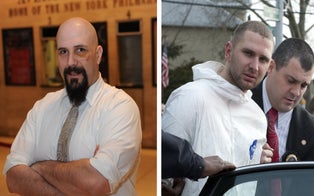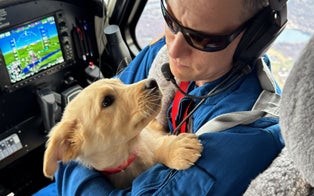Dr. James Nolan, an obstetrician, ended up becoming a key researcher on the Manhattan Project.
Dr. James F. Nolan was a doctor specializing in obstetrics and gynecology. He was a Captain in the U.S. Army Medical Corps, and delivered babies at a secret research facility in Los Alamos, New Mexico.
Nolan was also one of a few researchers on the Manhattan Project, which led to the development of two atomic bombs that were dropped in Hiroshima and Nagasaki the summer of 1945, killing hundreds of thousands of people, leveling the two Japanese cities, and ending the second World War.
Today, his grandson Jim Nolan, a professor of sociology at Williams College, is making sense of his grandfather’s role in the destruction in his new book, “Atomic Doctors: Conscience and Complicity at the Dawn of the Nuclear Age."
His interest in his grandfather’s story started about eight years ago, when his dad passed away and his mom visited with a box of memorabilia his dad saved. “I couldn't believe what was there. Photographs of Tinian Island, the Mushroom Bomb, correspondence, correspondence between my grandfather and Oppenheimer, artifacts, all his military papers, his medical assessment of the members of the Enola Gay.”
The Enola Gay was a Boeing B-29 Superfortress bomber that ultimately carried the atomic bombs to Japan.
Nolan was one of the first doctors at Los Alamos, and his primary job was to deliver the babies of scientists’ family members that also lived there.
When officials began developing the Manhattan Project, they knew there would be safety and health concerns and Nolan was assigned to monitor the radiation related to the blast.
Nolan was also tasked with escorting the bomb on the USS Indianapolis from San Francisco to Tinian Islands, a small Pacific island neighboring Guam, which the United States captured and turned into a military base.
“They literally took the Little Boy bomb and bolted it to the floor in the flag lieutenant's cabin,” Jim said. “My grandfather sat there with a Geiger counter measuring it during the trip. And they were the only ones on the ship that were to know about it. Even the captain of the USS Indianapolis didn't know what the cargo was that they were carrying.”
Nolan was there for the final construction, and cited concerns with radiation to the last moment.
Not only did the bombs cause enormous destruction immediately, killing hundreds of thousands of civilians in each bombing and destroying everything in its wake, but it did continue to have lasting effects. More people continued dying in the months after the initial blasts, and even more died in the decades following from cancer and other radiation-exposure related illnesses.
When the American crew returned, Nolan was one of the physicians that gave them medical examinations, including a “medicinal shot of whiskey.”
Nolan was among the first that made a visit to Hiroshima a month later.
“What they saw was absolutely horrifying,” Jim said. “It was just devastating. And as it concerns my grandfather, he never talked about it. I never ever remember him talking about it. His own daughter, who I interviewed for the book, never remembers him talking about what he saw in Japan.”
Nolan returned to civilian practice after the war and became a cancer researcher. He died in 1983, at the age of 68 of cardiovascular disease -- possibly exacerbated by the effects of radiation exposure.
“In as much as my grandfather did talk about it, he would defend it according to the dominant narrative, that it ended the war, it saved American lives,” Jim said. “That said, I think it troubled him on a deep level in ways that he didn't talk about. When people would ask him, ‘Oh, you were on the Manhattan Project, what did you do?’ he [said], ‘Oh, I just delivered the babies.’”
RELATED STORIES





